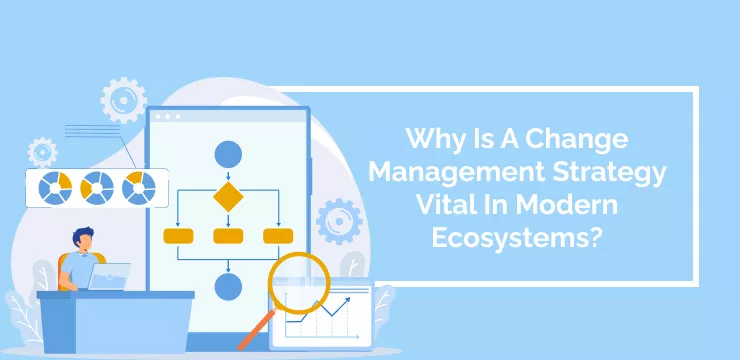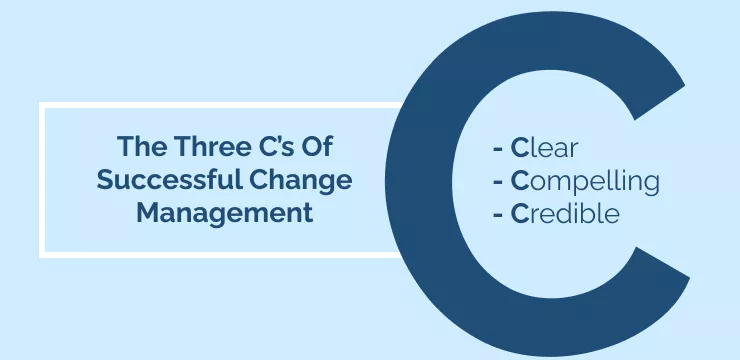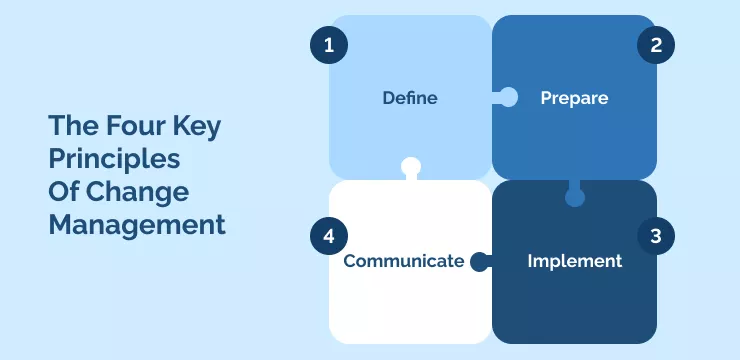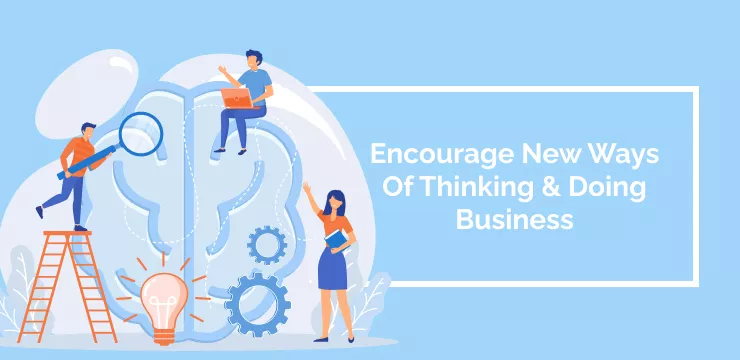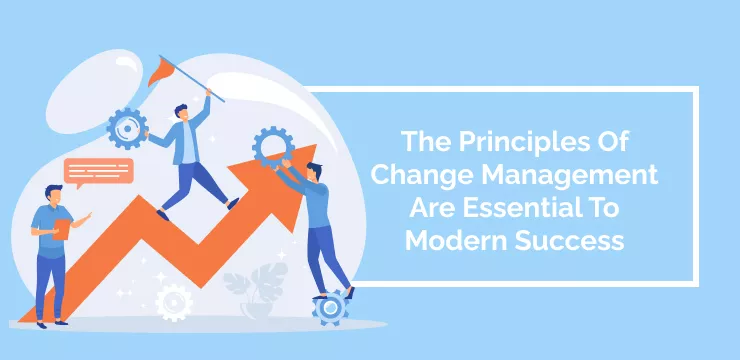
Change is more prevalent now than ever. With technology progressing so quickly, staff within today’s organizations face many challenges. Employees struggle to keep up to date with training for the hundreds of new apps released yearly and constant updates to many different processes. These changes create the need for change management principles.
Management supports staff through the intellectual and emotional challenges of experiencing individual and structural change. Change management principles give management the tools they need to support change.
But what is change management? Why is a change management strategy vital in modern ecosystems? And what are the three Cs of change management? We will explore all these questions and several others, beginning with a definition.
What Is Change Management?
Change management equips senior and c-suite staff with the tools to support their team members through massive structural change. This action allows change to become maintained and successful as new behaviors become the new status quo, optimizing business processes and outcomes.
Examples of where businesses need change management are intelligent regeneration, package versioning, state control, library control, configuration management, and turnover management.
Gartner reports that just 39% of employees feel able to respond to the changing needs of their business and the customers it serves. This statistic highlights the need for change management within any company today.
Why Is A Change Management Strategy Vital In Modern Ecosystems?
Change management is vital for a company to successfully adopt and implement new changes. Employees must be able to understand, agree with, and work efficiently during the transition – organizational change is essential for companies that want to succeed and grow.
Inadequate change management within a company can be costly in terms of time and resources, leading to reduced employee morale and subpar skill development. Without effective organizational change management, a company is more likely to fail.
Companies must use change frameworks such as the three Cs of successful change management to promote success.
The Three C’s Of Successful Change Management
The three C’s of successful change management are Clear, Compelling, and Credible. They are needed because organizations lead large-scale cultural changes and digital transformation strategies that often include significant amounts of detailed information for staff to process. Employees respond to these demands by asking,
“What does this change mean for me?”
This scenario is where the three Cs of successful change management principles come into the equation. The first of the three Cs that help effective change leaders navigate change is communicating clearly. Understanding this is the starting point for senior management as they begin to share change management principles in a way that staff will find helpful and relatable.
Clear
To manage change successfully within your company, you first must ensure that your message is clear. This means:
- Use language that everyone can understand.
- Be explicit about what the transformation will entail on an individual and collective level.
- Try to explain in detail what needs to improve as part of this process.
When the message is clear, staff can carry out instructions more easily.
Compelling
Change begins with people. Companies must change processes and systems, but without the support of the people who will implement these changes, transformation is impossible. Focus on building a solid case for change that explains why your team should want to transform.
Credible
Positive and negative changes produce natural human reactions of fear and doubt. Let’s say a colleague tells you they won the lottery, and they will share half with you. Although, on the surface, you could perceive this positively, you would most likely question if the colleague was telling the truth or whether they would be so generous. Companies must establish trust between themselves and their staff to accept such positive change.
You can’t simply have the CIO talk about culture change to active leaders and then stop. CIOs must ensure that the message is spread formally and informally throughout all levels of the change management team. This way, CIOs build trust using their understanding of the company’s existing culture within the organization.
“I believe that transformation of any kind is more about culture and communication than change management because it allows individuals to turn to someone trustworthy for a better understanding of the change.” CIOs do this by conveying a credible message to team members. This way of communicating ideas for change builds credibility for the messaging.
The Four Key Principles Of Change Management
There are two sets of proven principles within change management, and the first is the four key principles: definition, preparation, and structured implementation. These principles allow change leaders to communicate and manage change, so employees successfully maintain it. These four key principles equip the company with the necessary tools to create the change management principles foundation.
1. Define
It’s a common misconception that you only need to answer these questions truthfully to change something successfully. In reality, you first must believe in the benefits of said change. To illustrate, let’s say your objective is to changes flow Better within The Coaches at Change.
Questions provide essential data to help managers learn how to work together more efficiently with teams and groups before proceeding with anything else.
Examples of such questions include:
- Why do we need this change?
- How will the organization benefit from this change?
- How will each role and department staff feel about this change?
- How will it affect teams and groups within the company – including myself?
- What training and support will we need to implement this change?
Answering these questions forms the basis for the preparation stage in which you answer these questions with solutions.
2. Prepare
Companies achieve successful change using structured, relevant planning that fits the needs of their organization. Additionally, how change leaders manage change projects differs based on the company. Some have very structured change methodologies, while others permit greater freedom.
To successfully implement change, consider a few key factors:
- Investment: Who will sponsor the change? How can you engage and secure high-level support?
- Engagement: Once you have sponsorship, which should be involved in designing and implementing the change? For example, do you need external expertise, or can internal resources suffice?
- Motivation: To ensure the changes are effective, try to gain buy-in from people across the business. How will doing this help achieve your goals?
- Impact: This is the stage before you take action. Finally, think about how success will look. How will you predict and assess the effects of needing to make a change?
3. Implement
There are many different ways that you can choose to implement your changes. Kotter’s 8-Step Change Model is just one example of a strategy that explains how to add a sense of urgency into your actions so you maintain progress and everyone supports your changes.
The Change Curve is a helpful reminder to respect people’s emotions as you carry out your plan. It explains the psychological stages we experience during organizational alteration – from disbelief and denial to eventual total emotional and intellectual investment in the new status quo.
By following these steps, you can introduce change smoothly and efficiently:
- First, ensure that everyone included in the changes comprehends what needs to take place – and how it will influence them.
- Second, define success criteria for your changes using metrics that, once you have established, you record and review frequently.
- Companies must map and identify key stakeholders to define their involvement in the change. Additionally, address any training needs that may disrupt the implementation process.
- It is also helpful to appoint “change agents” to help carry out the new practices – these people should act as role models for what the company expects of staff.
- Finally, finding ways to change people’s habits so they default to the new agreed-upon practice and identifying support throughout the change should be implemented.
4. Communicate
The success or failure of change management rests heavily on communication. The messaging must be clear so your target understands the changes and why the company is implementing them. But it’s not only logical arguments that will get you where you need to go; sometimes, people need emotional incentives.
Incorporate your planned changes with your organization’s mission or vision statements. Doing this helps people see how it benefits the company and gives them an inspiring glimpse of the future. Another critical factor is good stakeholder management to ensure everyone receives updates as needed so your project can succeed.
The ADKAR Change Management Model is a helpful way to ensure that your communications about a change are clear and concise. It covers five key points:
- Awareness of the need for change.
- Desire to participate in and support it.
- Knowledge of how to change.
- Ability to change.
- Reinforcement to sustain the long-term change.
The ADKAR model focuses on the psychology of employees to understand and support their experience of organizational change. However, many other change models supporting change management principles, such as Lewin’s and Nudge’s, can help effective leaders navigate successful change management.
Once your company has begun to plan and implement the four key principles of change, it is time to utilize the ten guiding principles of change management.
The Ten Guiding Principles Of Change Management
The ten guiding principles of change management are the second set of principles in achieving change, giving more detail than the key principles above. The ten guiding principles go into more detail, ensuring that change leaders are equipped with a structured approach to motivate staff at every level to understand and implement change initiatives within their role and department. The first of these steps involves defining the company culture as a means of leading change.
1. Define The Culture & Lead With It
Business leaders must understand the established culture and how to lead with it as part of the proposed transformation strategy. Frameworks exist to help leaders define their company’s culture, such as:
- The McKinsey 7S Model
- The Cultural Iceberg Model
- Hofstede’s Model
Suppose some business leaders are unfamiliar with how to define their company’s culture. In that case, the company can hire external agents like change management consultants to support specific areas of a transformation strategy, such as determining the culture. Leaders must be aware of these models and others to decide which is best to invest time in defining company culture.
Culture is instrumental in a successful transformation strategy. A deep understanding of it can help reduce employee resistance to change by allowing leaders to understand what employees are likely to feel most challenging about the change process and prepare in advance how best to support them. When change leaders have defined their culture, they can then use it to drive change by playing to the culture’s strengths and building on its weaknesses.
2. Implement Collaborative Decision-Making
It is essential for any major initiative for change to incorporate collaborative decision-making. Although most leaders say they involve employees when strategizing around change, Gartner reports that only 42% of employees feel like their organization makes them feel heard and valued. Often, leaders are afraid of being burdened with too many opinions of looming deadlines, so they make decisions and then ask for employee feedback as more of a formality.
When a company realized its decision-making process was outdated, it created the Open Decision Framework as an improved method of organizational change management. Organizations give all new hires this tool on their first day, which outlines how leaders should include different stakeholders in the decision-making process. The goal is to transform organizational culture so employees can contribute to change strategies, but overwhelming them with options will only hinder productivity.
Rather than basing an individual’s say on rank or how long they have been with the company, we ask leaders to consider other essential factors such as expertise, impact, and customer service. This way of thinking ensures that everyone understands why a decision was made, not just who was involved in the process. With this level of transparency, no one is surprised by a judgment, and everyone trusts that it is the best option – even if they don’t always like it.
Open decision-making works for the company because it operates on a meritocracy instead of a democracy. In a meritocracy, the best ideas always win- no matter where they originate. This situation might cause a slowdown in the decision-making process, but more time spent upfront will ultimately result in more significant savings.
3. Optimize Change With A Layered Approach
Organizations must optimize their change initiative using a layered approach. Strategic planners often overlook the damage mid-level and frontline employees can do to a change initiative. If change leaders give these staff a voice early in the decision-making process, it will make rolling out the change much smoother.
Staff constantly interacting with customers or clientele usually know where potential problems may occur and how consumers react to new changes. Their investment in the company can also help plan convoluted change initiatives go more smoothly, whereas resistance from employees will make implementation an uphill battle.
Firstly, identify key stakeholders in your organization. If you do not have a customer-facing team in your company, who could give valuable information on how external stakeholders might perceive change? Next, receive feedback from these teams on this subject. And thirdly, show these teams that their feedback has been listened to and actioned.
Change leaders’ communication is essential throughout this process, but several team members become change agents when they perform it effectively. They are inflamed and motivated by their understanding of and desire to communicate the needs and structural and individual incentives for change to others.
In these ways, organizations lead and optimize change using a layered approach and involving key stakeholders as much as possible throughout each change process.
4. Utilize Both Rational & Emotional Decision-Making
Often, leaders attempt to instigate change by solely listing off strategic business objectives such as “we will enter new markets” or “our goal is to grow 10% every year for the next five years.”
Although these ambitions are adequate in a practical sense, they rarely manage to touch people emotionally and ensure that they would be genuinely committed to the proposed changes. Companies only achieve effective change management when employees feel emotionally connected and engaged with ideas around change – feeling like they are part of a larger picture they can contribute to and will benefit them.
Hewlett-Packard CEO Meg Whitman and her staff use this idea in their transformation attempts. They’re trying to create a close personal connection between HP and its employees by relying on the company’s cultural background and traditions. For example, they broke down the fences surrounding the executive parking lot and moved some top executives into cubicles. These symbolic gestures remind everyone at HP of the “HP Way” ethic, which emphasizes how good your work is rather than your position in the company hierarchy.
5. Encourage New Ways Of Thinking & Doing Business
Once the elements are in place, change leaders often assume that staff will change their behaviors. They believe that once formal components like incentives and directives are in place, change will be cemented. People who work cross-functionally will start collaborating because that’s what the lines on the chart dictate. Managers become clear communicators due to a strategy mandate. But change management is a lot more complex than this, and new ways of thinking and doing business are needed to implement change in the long term.
What is truly essential to the success of any initiative are the everyday behaviors that people display. To achieve this goal, define a few key behaviors necessary for success. Next, make sure those behaviors are prominent in everything you do moving forward.
From the beginning, top-level executives must display these new behaviors themselves if they want employees to buy into the change. Staff need to see that c-suites are all living out the transformation they state is essential for the company to believe that transformation is underway.
The leaders of a large, global manufacturer seeking to avoid bankruptcy realized that the company had become disconnected from its customers because of numerous cultural issues. For example, there were too many layers of management without enough accountability. Additionally, the managers tended to be slow, risk-averse and focused on internal matters instead of customer needs.
The change team didn’t want a lengthy, drawn-out turnaround; they wanted leaders to adopt three behaviors:
- Make decisions relatively quickly instead of waiting for weeks or months.
- Get input from frontline leadership and have open discussions with them.
- Encourage middle and lower ranks to speak with customers directly.
The changes in behavior were easy to implement because they were both restricted and finite. Rather than leaders thinking their way out of old habits, they acted “as if” the company had already behaved this way. These new behaviors allowed the company to avoid bankruptcy due to increased productivity and revenue.
6. Engage With Your Entire Organization
Change managers often make the mistake of imagining they can start an initiative with a strong message of change, and people will understand what to do to implement it. The reverse is true, as employees require constant communication during the rollout and after the plan’s major elements are in place. Additionally, different types of communication effectively reinforce one another. This point explains why HP’s tearing down of the fence was so important- it symbolized putting words into action.
The company’s executives announced that the company would be restructuring to focus more on digital adoption, affecting everyone working for the publisher. To ensure that everyone was informed and had a chance to voice concerns, they hosted a series of meetings in town halls where they gave people the news and allowed time for questions. In addition, they held function-wide meetings focused on affected areas like finance or human resources so that employees could better understand how these changes would play out.
Constantly communicating different aspects of the plan to employees kept morale high and allowed key stakeholders to be invested in the company’s success by enabling the broad involvement of all members of the organization. The company also had a series of “PIE chats, ” which covered performance, innovation, and execution topics. Lastly, they created an internal trade fair to present all the digital progress various teams within the company had made.
7. Broaden The Leadership Approach
The most effective leaders in transformation strategies understand that change leadership can come from any level. Therefore, to lead change management is to realize that influential employees from every role and department have an essential insight into the transformation process. Gartner’s findings state that just 39% of employees feel able to respond to changing customer and business needs. However, when employees become agents of change, they feel more in control and become innovative and creative, implementing change management principles into every process.
Leaders must influence organizational culture transformation in this way to positively affect employee trust and understanding. Doing so reduces change management demands as the staff is motivated to implement the necessary changes.
Business leaders who hold an unofficial yet vital role in organizations are known as “special forces.” They might include a highly respected field supervisor, an innovative project manager, or a helpful veteran receptionist. Successful companies that manage to implement large changes identify these people early and find ways to welcome their involvement as participants and mentors.
Informal leaders generally fall into one of three categories:
- Pride builders motivate and inspire others to take pride in their work. Those influenced by them feel good about working for the organization and want to do more than what is required.
- Trusted nodes are people others go to for information as they know a lot about the organization’s culture. They can be relied on to give accurate information – especially when someone wants to know if those leading a change initiative will follow through with it.
- Change or culture ambassadors exemplify the change the organization is making and understand why it is crucial. They help communicate this message to others.
Before senior management can engage with critical informal leaders, you must identify them. Network analysis is the best way to do this in a large organization. This action involves mapping out connections and observing whom people communicate with most often. Doing this provides complementary information to the formal organization chart. It allows you to lead effectively from anywhere in the organization, using the combined strengths of all staff to support change.
Business leaders must always begin communicating a new change management plan to team members with clear definitions of what the transformation strategy aims to achieve.
A transparent change management plan, accessible for staff and updated as the change team adjusts it.
8. Foster Formal Solutions
Transformation requires more than staff behavior changes. To maintain instability in the long term, you must redesign the company structure and how you distribute operations, training, rewards, and development programs.
The clients of a law firm saw its culture as unprofessional and only concerned with its members. The lead partner group decided that they would have to conduct mentoring and development more formally. The organization’s training program needed a critical review since it couldn’t achieve the proposed change.
As a result, the change team created a development committee and sought out experienced staff members willing to help new hires implement change. They felt positive when they received many volunteers who designed an intricate development program and started working with associates immediately.
Although the initiative had started well, it quickly began to lose steam as people who were initially enthusiastic about it became disengaged. After debriefing those involved, leadership identified the problem: There were no formal mechanisms to support or reward this participation.
Because bonuses only took work output into account and not the training of others, senior partners seemed to look down on members of the development committee. Firm leaders soon realized this problem and changed firm policy accordingly, starting with a way for the compensation committee to factor in contributions made by trainers.
9. Promote Informal Solutions
Even if all of the tangible aspects needed for change are in place, people can still revert to old habits that delay progress. This point is why it’s essential to have both formal and informal solutions working together.
A technology company wanted to start focusing on customers instead of only cutting costs after ten years. Through surveys, they discovered that many customers were unhappy with how often products had flaws when released. To fix this issue, they implemented new procedures and metrics for product development, process quality controls, and cross-teaming on the front lines.
One of the most impactful changes was informal and cultural ways to communicate change. They changed the motto by which the frontline employees lived. The old saying promoted during our cost-cutting efforts, “ship by any means,” gave way to a new mantra: “if it’s not right, don’t ship it.” They brought pride builders to show everyone that we needed to prevent any flawed products from being sold, even if that meant adding extra inspection steps or taking production down for a bit.
Through these actions, change leaders shifted the company focus from ‘We do as we are asked to an ethic of ownership in the product by asking people at every level to be responsible for the quality and celebrating improvements.
10. Evaluate & Adjust
Evaluation and adjustment are essential to all successful change efforts. Implementing change is a long-term project requiring a large amount of regular scheduled assessment and adjustment. Review is needed to ensure positive behavioral shifts are maintained, reducing office politics.
Many organizations don’t measure their success correctly before moving on from a transformation project, eager to claim victory. Leaders need to take the time to evaluate what is and isn’t working to assess future steps. Without this feedback loop, there will be inconsistencies throughout an organization’s change process, depriving it of necessary information regarding how best to support long-term improvements.
A well-known consumer goods company had recently pledged to lower their costs globally. The leaders at the company designed an ambitious change plan and started to implement it immediately; as the metrics appeared effective, they continued with this strategy. However, wanting to ensure that everyone understood this was an ongoing commitment, they launched a series of pulse surveys and focus groups discussing the need for change and the new behavioral expectations of employees.
The first survey showed that only 60% of respondents understood the message. The company then brought in informal leaders to help spread the word about the initiative. They continued to conduct surveys and focus groups on measuring progress until most staff felt prepared. These processes increased employee engagement.
If you’re a leader passionate about producing long-term, positive change, use these ten principles as your guide. The steps necessary to enact this transformation will be complex, but the demand for such solutions is only growing.
The Principles Of Change Management Are Essential To Modern Success
Change is all around us – whether we like it or not, the business world is a constantly evolving, living being. The key to success lies in how we manage that change. By understanding and practicing the principles of change management, we can ensure that the changes we make are meaningful for employees who understand them and become passionate about change.
With the speed of digital innovation today, businesses cannot afford to delay putting these principles into practice to foster digital resilience. Once you have begun implementing the principles, it is easy to see the positive impact as business outcomes and processes improve and staff becomes more motivated and productive in the long term.
Tristan Ovington
Tristan Ovington is a professional senior writer and journalist, specializing in providing expert insights on various topics such as digital adoption, digital transformation, change management, and Cloud apps. He delivers his knowledge through accessible online content that is data-driven and presented in a friendly tone, making it easy for readers to understand and implement.


